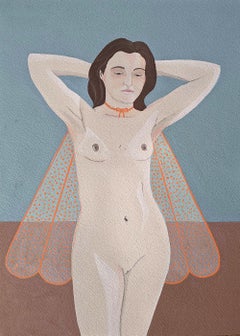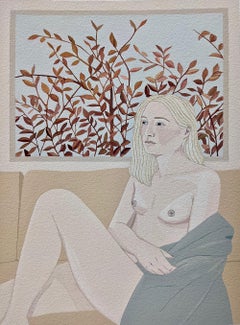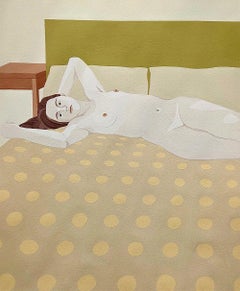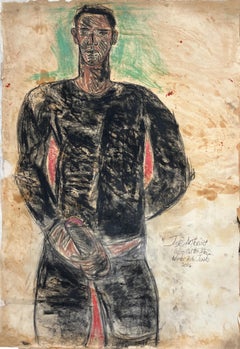Ellen Von Wiegand Nude Drawings and Watercolors
b. 1987
Ellen has a background in Art History. She completed her Masters degree in Contemporary Art at Christie's Education in 2011, and received her BA in Art History from John Cabot University, Rome in 2010. She began to develop an interest in printmaking while studying the linocuts of Picasso and Der Blaue Reiter during her time at Christie's, and she is largely self-taught in the craft.(Biography provided by Joanne Artman Gallery)
to
3
3
3
2
1
Overall Height
to
Overall Width
to
3
3
3
2
2
1
1
1
3
12
69
69
41
40
3
3
3
3
3
Artist: Ellen Von Wiegand
Fitted Wings, gouache painting of female nude with wings, blue background, frame
By Ellen Von Wiegand
Located in Dallas, TX
Beautiful original gouache paintings on Arches watercolour paper by Ellen Von Wiegand are float mounted and framed in white, all archival materials, and ready to hang. "Fitted Wings"...
Category
2010s Contemporary Ellen Von Wiegand Nude Drawings and Watercolors
Materials
Archival Paper, Gouache
Under the Red Leaves gouache painting of female nude, pastel colors, white frame
By Ellen Von Wiegand
Located in Dallas, TX
Beautiful original gouache paintings on Arches watercolour paper by Ellen Von Wiegand are framed in white, all archival materials, and ready to hang. "Under the Red Leaves" is a gorg...
Category
2010s Contemporary Ellen Von Wiegand Nude Drawings and Watercolors
Materials
Gouache, Archival Paper
The Sun Dazzled the House with Light, gouache painting of female nude on yellow
By Ellen Von Wiegand
Located in Dallas, TX
Beautiful original gouache paintings on Arches watercolour paper by Ellen Von Wiegand are float mounted and framed in white, all archival materials, and ready to hang. "The Sun Dazzl...
Category
2010s Contemporary Ellen Von Wiegand Nude Drawings and Watercolors
Materials
Gouache, Archival Paper
Related Items
1900s French Atelier Life Drawing Academic Sculpture of Male Nude Figure
Located in Cirencester, Gloucestershire
Life study drawing
original atelier drawing
by the French artist, Jeanne Nachat (1898-1984)
Nachat attended the prestigious Académie des Beaux-Arts in Pa...
Category
Early 20th Century Academic Ellen Von Wiegand Nude Drawings and Watercolors
Materials
Pencil, Charcoal
H 25 in W 18.75 in D 1 in
Jose antonio, Martes 7 de julio, Figurative painting
By Celso José Castro Daza
Located in Miami Beach, FL
Jose antonio, Martes 7 de julio 2016, by Celso Castro
Crayon Pastel on archival paper
Image size: 60 H in. x 38 in. W
Unframed
On The back of the painting:
Abstract, 1986
Pencil a...
Category
1990s Contemporary Ellen Von Wiegand Nude Drawings and Watercolors
Materials
Pastel, Crayon, Archival Paper
H 60 in W 38 in D 0.1 in
Art Deco Pulp cover or pin-up magazine cover
By Peter Driben
Located in Miami, FL
Pulp cover or pin-up magazine cover
signed lower left
some foxing throughout
work is framed
Category
1920s Art Deco Ellen Von Wiegand Nude Drawings and Watercolors
Materials
Oil
In Chains - Male Nude original art by Paula Craioveanu
By Paula Craioveanu
Located in Forest Hills, NY
"In Chains"
Male Nude inspired by St Sebastian.
Ultramarine tempera on colored paper.
Size 27.5x19.5in / 70x50cm .
See the other nudes from the same series.
Shipped rolled in a...
Category
2010s Contemporary Ellen Von Wiegand Nude Drawings and Watercolors
Materials
Tempera, Carbon Pencil
H 27.5 in W 19.5 in D 1 in
1900s Original French Atelier Life Drawing Posed Man Head in Hands
Located in Cirencester, Gloucestershire
Life study drawing
original atelier drawing
by the French artist, Jeanne Nachat (1898-1984)
Nachat attended the prestigious Académie des Beaux-Arts in Pa...
Category
Early 20th Century Impressionist Ellen Von Wiegand Nude Drawings and Watercolors
Materials
Pencil, Charcoal
H 24.5 in W 19 in D 1 in
Nude Study
By Georges Artemoff
Located in Los Angeles, CA
Original charcoal drawing by Russian-French artist, from the Art Deco period.
22 x 10 Inches without the frame.
George Artemoff
1892 - 1965
George Artemoff was born in the Don Va...
Category
1920s Art Deco Ellen Von Wiegand Nude Drawings and Watercolors
Materials
Archival Paper, Charcoal
Classical Roman Nude Man draped in Robes, signed French drawing
Located in Cirencester, Gloucestershire
The Roman Man
French artist, 19th century
pencil drawing on paper, unframed
13 x 11 inches
private collection, France
the painting is in overall good and sound condition - very frag...
Category
19th Century Old Masters Ellen Von Wiegand Nude Drawings and Watercolors
Materials
Pencil
Male Nude - Contemporary Figurative Watercolor Painting, New Expressionism
By Maciej Olekszy
Located in Salzburg, AT
The artwork on paper will be sent unframed to you.
Maciej Olekszy was born in 1982, Poland. Graduated from the Academy of Fine Arts in Poznan, Poland in 2007. Faculty of Painting i...
Category
2010s Contemporary Ellen Von Wiegand Nude Drawings and Watercolors
Materials
Paper, Watercolor
1920's French Charcoal Sketch of Seated Nude Lady The Artists Model
Located in Cirencester, Gloucestershire
"The Artists Model"
French School, circa 1920's
charcoal drawing on paper, unframed
paper: 24.5 x 17.5 inches
Condition report:
The painting is in good and sound condition
Category
Early 20th Century Impressionist Ellen Von Wiegand Nude Drawings and Watercolors
Materials
Charcoal
A Space for Two original blue ultramarine nude by Paula Craioveanu
By Paula Craioveanu
Located in Forest Hills, NY
"A Space for Two"
Space for love and passion.
Part of "Nude in Interior" series.
Original work on colored paper, with blue ultramarine tempera on red colored paper, inspired by Mati...
Category
2010s Contemporary Ellen Von Wiegand Nude Drawings and Watercolors
Materials
Paper, Tempera
H 27.5 in W 19.5 in D 0.2 in
Gouache Painting Jules Pascin Hand Signed Woman in Boudoir German Expressionism
By Jules Pascin
Located in Surfside, FL
Genre: German Expressionist
Subject: Woman
Medium: gouache paint
Surface: Paper board
This is hand signed lower right.
Framed it measures 17.25 X 15.5, sheet 12 X 10
This came from a Jewish estate. there was no additional paperwork or provenance.
Julius Mordecai Pincas (March 31, 1885 – June 5, 1930), known as Pascin Jules...
Category
Early 20th Century Expressionist Ellen Von Wiegand Nude Drawings and Watercolors
Materials
Paper, Cardboard, Gouache
Futurist, Novecento Italiano, Mid Century Italian Painting, Figures at the Baths
By Anselmo Bucci
Located in Cotignac, FR
Mid 20th Century Italian Futurist, Novecento Italiano, work on paper, signed bottom right and with dedication top right (see photos).
The subject is bathers enjoying the delights of a spa and sauna with colourful tiling to the background. The classical figures languorously positioned in repose but the central 'white' figure in stark contrast. The play on colours gives the work a vibrancy. The drawing is possibly a preparatory sketch for a larger work or mural.
A vibrant, exciting and colourful work incorporating the styles of Futurism and the Novecento Italiano movement and with the influences or artists such as Anselmo Bucci, Adami, Jean Helion, Maryan, Achille Funi and Ugo Guidi.
Anselmo Bucci was born in 1887 in Fossombrone in the district of Pesaro. Even though he studied Classics, right from a tender age he showed a talent for drawing and, when his parents moved near to Florence, he was taught by the artist Francesco Salvini.
In 1904 the family settled in Monza and so the boy was able to study for a year at the Accademia di Belle Arti di Brera, but he did not follow up this educational experience and in 1906 he left Italy for Paris where he came into contact with the Parisian avant-garde, met fellow Italian artists such as Severini and Modigliani, and made friends with Picasso, Utrillo and Apollinaire. In 1907 he showed a painting at the Salon, but these Parisian years were most important for his love of engraving techniques – etching and dry point that enabled him to fully develop his themes characterised by movement.
On the outbreak of war in 1915 he returned to Italy and he enlisted in the same battalion as several Futurist artists such as Martinetti, Boccioni, Sant’Elia and Carlo Erba. In 1914 he won the silver medal at the Mostra dell’Incisione (Exhibition of Engravings) at Florence. In 1917 in Paris he published pictures of war scenes entitled “Croquis du Front Italien”. In 1919 he printed twelve lithographs entitled “Finis Austriae” again showing events from the war. At the end of the war he lived between Milan and Paris and he dedicated his time completely to his art with personal exhibitions, exhibiting at all the most important Italian and French shows, in Belgium, Holland and England.
In 1922, he established the group “Movimento del Novecento”, (Novecento Italiano), (20th century Movement) a joint venture with the artists Sironi, Funi, Oppi, Malerba, Dudreville and Marussig. Their aim was to return to figurative art in contrast with the growing extremism of the Avant-gardists. In 1925 he worked on the illustration of the first edition of Kipling’s The Jungle Book producing eight dry point plates.
In the early 30’s he lived in Bucci, Trieste, where he worked on the furnishing of the steamships for the Trieste Navigazione Libera, at the same time he continued to work on many book illustrations.
During the second European war he adapted to being a war artist recording the events of the war as he had done previously. Indeed the engravings depicting battles of the Marines and the Air Force belong to this period. In 1945, following the bombing of his house in Milan, he returned to Monza to his father’s home where he remained until his death.
Futurism was an Italian art movement of the early twentieth century that aimed to capture in art the dynamism and energy of the modern world. Futurism was launched by the Italian poet Filippo Tommaso Marinetti in 1909. On 20 February he published his Manifesto of Futurism on the front page of the Paris newspaper Le Figaro.
Among modernist movements futurism was exceptionally vehement in its denunciation of the past. This was because in Italy the weight of past culture was felt as particularly oppressive. In the Manifesto, Marinetti asserted that ‘we will free Italy from her innumerable museums which cover her like countless cemeteries’. What the futurists proposed instead was an art that celebrated the modern world of industry and technology:
We declare…a new beauty, the beauty of speed. A racing motor car…is more beautiful than the Victory of Samothrace. (A celebrated ancient Greek sculpture in the Louvre museum in Paris.)
Futurist painting used elements of neo-impressionism and cubism to create compositions that expressed the idea of the dynamism, the energy and movement, of modern life.
Chief artists associated with futurism were Giacomo Balla, Umberto Boccioni, Gino Severini.
After the brutality of the first world war, many artists rejected the avant-garde notions of futurism and other pre-war movements, by using more traditional and reassuring approaches, a phenomenon described as the ‘return to order’.
Novecento Italiano was founded by Anselmo Bucci (1887–1955), Leonardo Dudreville (1885–1975), Achille Funi, Gian Emilio Malerba (1880–1926), Pietro Marussig, Ubaldo Oppi, and Mario Sironi. Motivated by a post-war "call to order", they were brought together by Lino Pesaro, a gallery owner interested in modern art, and Margherita Sarfatti, a writer and art critic who worked on Italian dictator Benito Mussolini's newspaper, The People of Italy (Il Popolo d'Italia). Sarfatti was also Mussolini's mistress.
The movement was officially launched in 1923 at an exhibition in Milan, with Mussolini as one of the speakers. The group was represented at the Venice Biennale of 1924 in a gallery of its own, with the exception of Oppi, who exhibited in a separate gallery. Oppi's defection caused him to be ejected from the group, which subsequently split and was reformed. The new Novecento Italiano staged its first group exhibition in Milan in 1926.
Several of the artists were war veterans; Sarfatti had lost a son in the war. The group wished to take on the Italian establishment and create an art associated with the rhetoric of fascism. The artists supported the fascist regime and their work became associated with the state propaganda department, although Mussolini reprimanded Sarfatti for using his name and the name of fascism to promote Novecento.
The name of the movement (which means 1900s) was a deliberate reference to great periods of Italian art in the past, the Quattrocento and Cinquecento (1400s and 1500s). The group rejected European avant garde art and wished to revive the tradition of large format history painting in the classical manner. It lacked a precise artistic programme and included artists of different styles and temperament, for example, Carrà and Marini. It aimed to promote a renewed yet traditional Italian art. Sironi said, “if we look at the painters of the second half of the 19th century, we find that only the revolutionary were great and that the greatest were the most revolutionary”; the artists of Novecento Italiano “would not imitate the world created by God but would be inspired by it”.
Despite official patronage, Novecento art did not always have an easy ride in Fascist Italy. Mussolini was personally uninterested in art and divided official support among various groups so as to keep artists on the side of the regime. Opening the exhibition of Novecento art in 1923 he declared that “it is far from my idea to encourage anything like a state art. Art belongs to the domain of the individual. The state has only one duty: not to undermine art, to provide humane conditions for artists, to encourage them from the artistic and national point of view." The movement was in competition with other pro-Fascist movements, especially Futurism and the regionalist Strapaese movement. Novecento Italiano also met outright opposition. Achille Starace, the General Secretary of the Fascist Party, attacked it in the Fascist daily press and there was virulent criticism of its “un-Italian" qualities by artists and critics.
In the 1930s, a group of professors and students at the Accademia di Brera established an opposition group to Novecento Italiano. Among them was the director of the academy Aldo Carpi, and students Afro, Aldo Badoli, Aldo Bergolli, Renato Birolli, Bruno Cassinari, Cherchi, Alfredo Chighine, Grosso, Renato Guttuso, Dino Lanaro, Giuseppe Migneco, Mantica, Ennio Morlotti, Aligi Sassu, Ernesto Treccani, Italo Valenti, and Emilio Vedova (and later Giuseppe Ajmone...
Category
Mid-20th Century Futurist Ellen Von Wiegand Nude Drawings and Watercolors
Materials
Paper, Pastel, Crayon, Pencil
H 31.5 in W 43 in D 0.25 in
Previously Available Items
Shimmer, gouache painting of woman, pastel colors, white frame
By Ellen Von Wiegand
Located in Dallas, TX
Beautiful original gouache paintings on Arches watercolour paper by Ellen Von Wiegand are framed in white, all archival materials, and ready to hang. "Shimmer" is a gorgeous original...
Category
2010s Contemporary Ellen Von Wiegand Nude Drawings and Watercolors
Materials
Gouache, Archival Paper
H 14 in W 10 in D 1 in
Ellen Von Wiegand nude drawings and watercolors for sale on 1stDibs.
Find a wide variety of authentic Ellen Von Wiegand nude drawings and watercolors available for sale on 1stDibs. You can also browse by medium to find art by Ellen Von Wiegand in archival paper, gouache, paint and more. Much of the original work by this artist or collective was created during the 21st century and contemporary and is mostly associated with the contemporary style. Not every interior allows for large Ellen Von Wiegand nude drawings and watercolors, so small editions measuring 10 inches across are available. Customers who are interested in this artist might also find the work of Maciej Olekszy, Julita Malinowska, and Garek. Ellen Von Wiegand nude drawings and watercolors prices can differ depending upon medium, time period and other attributes. On 1stDibs, the price for these items starts at $1,400 and tops out at $3,500, while the average work can sell for $1,400.





